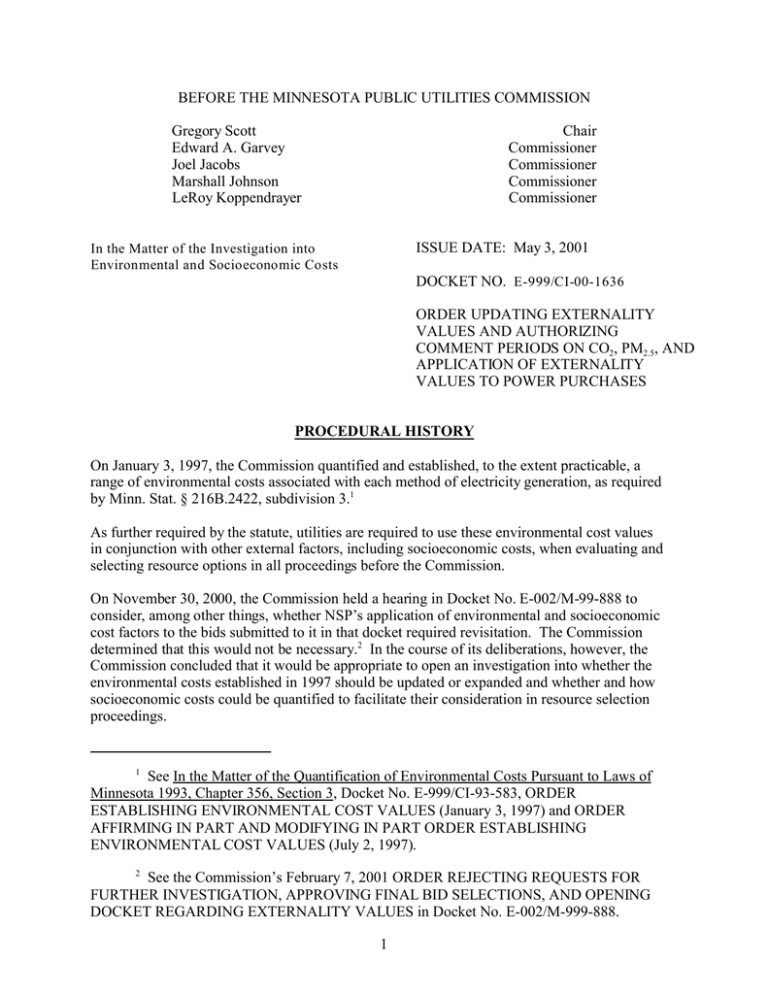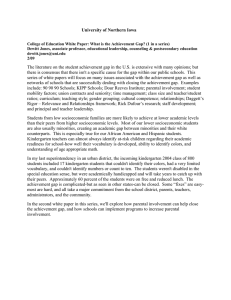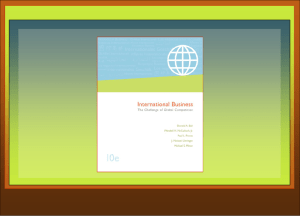BEFORE THE MINNESOTA PUBLIC UTILITIES COMMISSION Gregory Scott Chair Edward A. Garvey
advertisement

BEFORE THE MINNESOTA PUBLIC UTILITIES COMMISSION Gregory Scott Edward A. Garvey Joel Jacobs Marshall Johnson LeRoy Koppendrayer Chair Commissioner Commissioner Commissioner Commissioner ISSUE DATE: May 3, 2001 In the Matter of the Investigation into Environmental and Socioeconomic Costs DOCKET NO. E-999/CI-00-1636 ORDER UPDATING EXTERNALITY VALUES AND AUTHORIZING COMMENT PERIODS ON CO2, PM2.5, AND APPLICATION OF EXTERNALITY VALUES TO POWER PURCHASES PROCEDURAL HISTORY On January 3, 1997, the Commission quantified and established, to the extent practicable, a range of environmental costs associated with each method of electricity generation, as required by Minn. Stat. § 216B.2422, subdivision 3.1 As further required by the statute, utilities are required to use these environmental cost values in conjunction with other external factors, including socioeconomic costs, when evaluating and selecting resource options in all proceedings before the Commission. On November 30, 2000, the Commission held a hearing in Docket No. E-002/M-99-888 to consider, among other things, whether NSP’s application of environmental and socioeconomic cost factors to the bids submitted to it in that docket required revisitation. The Commission determined that this would not be necessary.2 In the course of its deliberations, however, the Commission concluded that it would be appropriate to open an investigation into whether the environmental costs established in 1997 should be updated or expanded and whether and how socioeconomic costs could be quantified to facilitate their consideration in resource selection proceedings. 1 See In the Matter of the Quantification of Environmental Costs Pursuant to Laws of Minnesota 1993, Chapter 356, Section 3, Docket No. E-999/CI-93-583, ORDER ESTABLISHING ENVIRONMENTAL COST VALUES (January 3, 1997) and ORDER AFFIRMING IN PART AND MODIFYING IN PART ORDER ESTABLISHING ENVIRONMENTAL COST VALUES (July 2, 1997). 2 See the Commission’s February 7, 2001 ORDER REJECTING REQUESTS FOR FURTHER INVESTIGATION, APPROVING FINAL BID SELECTIONS, AND OPENING DOCKET REGARDING EXTERNALITY VALUES in Docket No. E-002/M-999-888. 1 Accordingly, on December 14, 2000, the Commission issued a NOTICE OF INVESTIGATION AND COMMENT PERIOD. The Notice allowed interested parties to comment on the appropriate scope of the investigation, in response to the specific questions/issues set out on the attachment to the notice. The Notice stated that comments on the appropriate scope of the investigation would be due by January 16, 2001. On or before January 16, 2001, comments were received from Patricia Mack, Minnkota Power Cooperative, Western Fuels Association, Lignite Energy Council, Great River Energy, North American Water Office, Izaak Walton League of America, the Residential and Small Business Utilities Division of the Office of the Attorney General, Communities United for Responsible Energy, Minnesotans for an Energy-Efficient Economy, Xcel Energy, Center for Energy & Economic Development, Manitoba Hydro, Prairie Island Indian Community, Pimicikamak Cree Nation, Minnesota Department of Commerce, Tim Silverthorn, Otter Tail Power Company, Split Lake Cree First Nation, Minnesota Power, Dairyland Power Cooperative, the State of North Dakota, and Southern Minnesota Municipal Power Agency. Comments were filed by Interstate Power Company, Minnesota Department of Health, Clean Water Action Alliance, the Minnesota Pollution Control Agency and Nisichawaysihk Cree Nation on January 17, 2001, by Interstate Power Company on January 19, 2001, and by Missouri River Energy Services January 22, 2001. The Commission met on February 22, 2001 to consider this matter. FINDINGS AND CONCLUSIONS I. UPDATING ENVIRONMENTAL COSTS Many of the commenting parties pointed out that the existing environmental cost values are likely to be or become outdated if they are not updated periodically. A. General Reestablishment Process Some of the parties stated that the Commission should conduct a broad and thorough investigation into the various issues, in an attempt to set new environmental cost values covering a wider range of environmental and social impacts. However, both proponents and opponents of environmental costing pointed out that the original process proved to be extremely time-consuming. They stated that the Commission should not begin another process unless perceived benefits would justify the cost and, if the Commission were to reinvestigate, it should narrow the focus. The Commission notes that a comprehensive effort to reestablish environmental cost values would be very time-consuming and expensive. An extensive and costly contested case process would be required. Moreover, the benefit of such a proceeding is difficult to envision because the proponents of revisiting the values were unclear about what changes they believed would be found justified. In a comprehensive proceeding, for example, it is almost certain that some parties would argue for elimination of environmental cost values altogether, as they did in the previous proceeding, on the basis that it is not practicable to set them and use them. 2 B. Indexing in Lieu of a Reestablishment Process 1. Party Comments Many parties supported indexing the environmental cost values. Even some of the parties opposed to the use of environmental cost values suggested that indexing would be better than spending the time and effort to set new values. However, at least one party indicated that, even if the Commission adopts some type of indexing, new base values should be set before an index or set of indices is applied to the values. One party stated that the Commission should not index the values because individual utilities are in the best position to determine the escalation factors to use, which would be subject to Commission review. The party suggested that the only reasonable index to use is the time value of money. Another party indicated that automatic updating using one index would be inappropriate; rather the process of updating should be based on the nature and circumstances of each individual environmental cost value. Yet another party acknowledged the need to update the values periodically but stated that the new values should be based on actual and verifiable changes rather than the use of some arbitrary index. Other parties indicated that the Commission could establish a working group to select an appropriate index or that the Commission could establish an on-going externalities advisory group as a mechanism to achieve the Commission’s goals. Finally, one party indicated that, instead of indexing the values, the Commission could have damage-cost studies repeated every five or ten years. 2. Commission Analysis and Action The Commission finds that because the values were denominated in 1995 dollars, they will become out-of-date as inflation occurs and that indexing provides a practicable way to update values. A surrogate index is needed, however, because the values were based on environmental damage and there is no inflation index specific to environmental damages. Several parties suggested that the established values can be readily updated (indexed) using published indices. Proponents of indexing offered three indices: the Handy-Witman Index, the Gross National Product Price Deflator Index, and the Consumer Price Index (CPI). The Commission does not find the Handy-Whitman Index acceptable for the purpose at hand. It is a proprietary product, not freely accessible. More importantly, the construction cost increases and cost estimates it relies on do not sufficiently relate to the environmental damages/costs (values) to be updated here. The CPI and GNP Price Deflator Index are accessible to all free of charge and, although neither the CPI nor the GNP Price Deflator Index are designed specifically for the purpose of updating environmental costs, they are reasonably related to that purpose. Although the CPI and GNP Price Deflator Index are fairly comparable and both are reasonable choices for this purpose, the Commission prefers the GNP Price Deflator Index. The GNP Price Deflator Index, published by the U.S. Department of Commerce, is a broad-based inflation index. The Commission believes it preferable to the CPI for this purpose because the CPI is specific to consumer goods. 3 In sum, the Commission finds that applying the GNP Price Deflator Index to the established cost values is a reasonable way to meet the statutory requirement that the Commission establish cost values to the extent practicable. The Commission will so order. C. Proposals to Revisit or Establish Initial Cost Values for Certain Pollutants Cost values for three pollutants come in for particular scrutiny: CO2, PM2.5, and mercury. 1. Carbon Dioxide (CO2) a. Background In its January 3, 1997 ORDER ESTABLISHING ENVIRONMENTAL COST VALUES the Commission found it practicable to quantify and establish a range of environmental costs for CO2 as follows: CO2 $/ton Urban Metropolitan Fringe Rural Within 200 Miles of Minnesota .30 - 3.10 .30 - 3.10 .30 - 3.10 .30 - 3.10 While for other pollutants the Commission quantified costs of environmental damage occurring in Minnesota, for CO2 the Commission adopted values based on global damage because CO2 causes damages globally rather than regionally or locally. In order to treat CO2 emissions similarly with the other pollutants whose damages are found to be zero unless they originate within 200 miles of the Minnesota border, the Commission stated that it would treat CO2 emissions the same as other pollutants, i.e. as having no environmental costs if they originate more than 200 miles from the Minnesota border. To do otherwise, the Commission found, would overly complicate an already highly complex analytical process. While several parties argued that it was impracticable to quantify any values for CO2 because existing data is insufficient or unreliable, the Commission adopted the CO2 range that the ALJ had recommended after extensive contested case hearings. The Commission found that the ALJ’s calculation was well-reasoned and firmly based in the record. See the Commission’s extensive discussion of the ALJ’s report, the ranges it rejected, and the range it adopted. January 3, 1997 ORDER ESTABLISHING ENVIRONMENTAL COST VALUES, pages 24-27. Upon reconsideration, the Commission decided that it would not impose a range of environmental values for CO2 to prospective generating facilities beyond the borders of the State of Minnesota.3 Although the Commission found that it had the authority to require 3 In the Matter of the Quantification of Environmental Costs Pursuant to Laws of Minnesota 1993, Chapter 356, Section 3, Docket No. E-999/CI-93-583, ORDER AFFIRMING IN PART AND MODIFYING IN PART ORDER ESTABLISHING ENVIRONMENTAL COST VALUES (July 2, 1997), pages 3-5. 4 utilities to apply the adopted environmental cost values for CO2 to facilities outside of the State of Minnesota in resource selection analyses submitted in Minnesota, it also found that the “to the extent practicable” standard established in Minn. Stat. § 216B.2422 allowed it to take into consideration the concerns expressed by Dairyland Power Company and the State of North Dakota, particularly a concern for interstate comity in the process of establishing environmental cost values. While reducing the value for CO2 beyond the border of Minnesota to zero, the Commission clarified that it would continue the qualitative evaluation of the CO2 associated with such generation. Order at page 5. 2. Parties’ Comments In the current docket, parties on both sides of the issue have renewed their arguments and proponents of increasing the cost values for CO2 have cited further evidence of global warming due to anthropogenic emissions of greenhouse gasses such as CO2. No party, however, provided evidence to substantiate an increase in the environmental values (costs) that the Commission established for CO2 in the 1997 proceeding. Environmental advocates simply requested that the Commission convene a task force to determine whether adequate new scientific evidence was available to justify more formal consideration of the matter by the Commission. 3. Commission Analysis and Action The Commission finds no evidence in the current record to warrant further Commissioninitiated inquiry at this time. The Commission has set values after a long and thorough contested case process in 1997, including an Order and an Order after reconsideration. On appeal, the Minnesota Court of Appeals affirmed the Commission’s decision setting those values.4 Further, in the current docket, the Commission invited comment and no party has provided evidence that these values are not appropriate under the “to the extent practicable” standard. The parties continue to be free, of course, to engage in mutual discussions or unilateral development of the issue on their own. When and if any party believes that they have new scientific evidence that would warrant higher (or lower) values for CO2, they can bring that evidence to the Commission’s attention with a request for further consideration of the issue. 4. PM2.5 a. Background In its January 3, 1997 ORDER ESTABLISHING ENVIRONMENTAL COST VALUES, the Commission found it practicable to quantify and establish a range of environmental costs for particulates less than 10 microns in diameter (PM10) as follows: 4 In the Matter of the Quantification of Environmental Costs Pursuant to Laws of Minnesota 1993, Chapter 356, Section 3, 578 N.W.2d 794 (Minn.App.1998). 5 PM10 $/ton Urban Metropolitan Fringe Rural Within 200 Miles of Minnesota 4,462 - 6,423 1,987 - 2,886 562 - 855 562 - 855 No party sought reconsideration of this range for PM10. b. Parties’ Comments In this proceeding, several parties noted the availability of new information (developed after the Commission’s 1997 Orders) pointing to the possibility of establishing cost values for smaller particulates, those less than 2.5 microns in diameter (PM2.5). These parties noted that, relying on this new information, the federal Environmental Protection Agency (EPA) has adopted a new standard for this smaller sized particulate (PM2.5) and revised its standard on PM10. Other parties opposed the Commission considering updating the costs for particulates. They noted that EPA’s new standard for PM2.5 has been remanded, the EPA’s revision of the PM10 standard has been vacated, and an appeal to the U.S. Supreme Court is still pending. These parties argued that the Commission should not reconsider PM standards until the legal status of EPA’s proposed new standards has been settled. c. Commission Analysis and Action The Commission acknowledges the unsettled state of the EPA’s new particulate standards and the shadow this casts upon the evidence the EPA is relying on to support these new standards. However, it is not disputed that new scientific evidence does exist that convinced the EPA at least to adopt new standards. The Commission needs more information about this issue before deciding whether to proceed further or to terminate its consideration of PM2.5 and any impact that may have on the values (costs) it adopted for PM10. The Commission, therefore, will direct the parties to comment (based on the current state of science) on the feasibility of determining the costs of PM2.5 and the practicability of establishing externality values for PM2.5. 5. Mercury a. Background In its January 3, 1997 Order, the Commission declined to establish any externality values for mercury. The Commission found that the record did not support the practicability of quantifying values for mercury. In considering the record with respect to mercury, the Commission found that the level of reasonable uncertainty was exceeded, primarily due to the unreliability of the attempt to extrapolate mercury damages in reference to the air toxics index. In these circumstances, the Commission was unable to quantify the damage resulting from mercury emitted from electric generating plants. 6 The Commission noted, however, that the absence of a basis in the record of this proceeding for quantifying values for mercury did not mean that mercury’s effect upon the environment would be ignored when resource options were evaluated. The Commission also clarified that utilities would be required to explain in all filings subject to the Environmental Externalities Statute how mercury emissions were considered in the resource options identified in the filing. In addition, the Commission stated that mercury’s impact on the environment would be considered on a qualitative basis in such proceedings. Finally, the Commission noted that when better information on the valuation of mercury (or any other major pollutant) became available, any party believing that such information warrants quantifying and establishing a range of values for mercury could petition the Commission to initiate a new proceeding to do so. In its July 2, 1997 Order after reconsideration, the Commission rejected the arguments of some petitioners that the Commission had no authority to order the utilities to explain in all filings subject to the Environmental Externalities Statute how they had considered mercury emissions in the resource options identified in the filing. The Commission explained why this requirement was reasonable and well within its authority. No party sought review of this decision by the Minnesota Court of Appeals. b. Parties’ Comments In the current proceeding, the Commission sought comment on whether it should establish values for mercury and asked what information is available now that was not available when the Commission declined to set values for mercury in 1997. The commenting parties were about evenly divided between recommending that the Commission take no further action at this time and those who recommended that the Commission continue to explore, in light of newly available evidence, whether it is practicable to establish values for mercury. Parties opposing further Commission action on mercury at this time5 argued that the uncertainties that led the Administrative Law Judge (ALJ) in 1997 to recommend setting no mercury values and the Commission to adopt that recommendation have not been resolved. They noted that although the EPA has found that control of mercury emissions from coal-fired electric generating units is warranted, the agency has not yet promulgated regulations on mercury standards. These parties recommended that the Commission at least wait until EPA has established its regulatory program for mercury before beginning a controversial and costly effort to quantify the environmental costs of mercury. Parties favoring further action at this time6 cited the existence of scientific evidence 5 These parties included the State of North Dakota, the Lignite Energy Council, Western Fuels Association, Inc., Dairyland Power Cooperative, Minnkota Power Cooperative, Inc., Great River Energy, Minnesota Power, Xcel Energy, and the Center for Energy and Economic Development. 6 These parties included the Izaak Walton League of America, Minnesotans for an Energy-Efficient Economy, North American Water Office, Clean Water Action Alliance, 7 unavailable in 1997. Examples: • the Minnesota Pollution Control Agency (MPCA) cited EPA’s recent decision, based on evidence of damage from mercury emissions, to list utility boilers as a source of toxic emissions under Section 112(c) of the Clean Air Act; • the Izaak Walton League of America (ILWA) cited 1) the National Academy of Sciences study (Fall 2000) assessing the magnitude of the U.S. mercury emissions by source, the health and environmental implications of these emissions, and the availability and cost of control technologies; and 2) the EPA’s December 20, 2000 report and finding on the emissions of Hazardous Air Pollutants From Electric Utility Steam Generating Units; and • PCN cited works published since 1997 by the EPA, the Department of Energy, the National Academy of Sciences and others (14 publications in all) which it said had mitigated the practical problems associated with quantifying values for mercury. c. Commission Analysis and Action The Commission has consistently expressed its concern about the damage caused by mercury. In its January 3, 1997 Order, the Commission stated: No knowledgeable witness either denied or disputed that mercury causes damage to the environment or has consequences that people care about. Order at page 29. In that Order, as now, the real issue before the Commission is whether there is adequate evidence to support the practicability of quantifying values for mercury. The Commission is unable to make that determination based on the comments filed by the parties to date, but neither is it able to conclude that no such evidence exists, as several parties have urged. Because of its concern and the fact that new evidence has been cited, therefore, the Commission will direct the parties to file another round of comments to elucidate the specific and cumulative import of the new evidence on the ultimate question: is it practicable to set an environmental value for mercury? D. Socioeconomic Costs 1. Background Communities United for Responsible Energy, Pimicikamak Cree Nation, Manitoba Hydro, Alliant Energy, and the Minnesota Pollution Control Agency. The RUD-OAG recommended that the Commission consider establishing cost values for mercury to the extent that it is scientifically practical, but expressed concern about the time and resource commitment necessary by interested parties to devote to the project. The Department simply stated that if sufficient information on mercury emission and mercury damages now exists, a cost value should be assigned to mercury. 8 Minnesota’s externalities statute states: Subd. 3. Environmental costs. (a) The commission shall, to the extent practicable, quantify and establish a range of environmental costs associated with each method of electricity generation. A utility shall use the values established by the commission in conjunction with other external factors, including socioeconomic costs, when evaluating and selecting resource options in all proceedings before the commission, including resource plan and certificate of need proceedings. (Emphasis added.) The statute draws a distinction between environmental costs and socioeconomic costs. Both are “external factors” that utilities must consider when evaluating and selecting resource option, but while the statute requires the Commission to quantify and establish a range of values for environmental costs (to the extent practicable) it does not direct the Commission to do so for “other external factors, including socioeconomic costs.” Regarding such “other external factors, including socioeconomic costs,” however, the statute does require utilities to evaluate and select resource options in light of such factors as well as in light of the range of values for environmental costs established by the Commission. In its January 3, 1997 ORDER ESTABLISHING ENVIRONMENTAL COST VALUES, the Commission reflected this distinction as follows: The Commission notes that the Environmental Externalities Statute (Minn. Stat. § 216B.2422, subd. 3(a) prescribes a two-stage process: Stage 1 -- quantification and establishment of a range of environmental costs to the extent practicable and Stage 2 -- use or application of the values in conjunction with other external factors (including socioeconomic costs) when evaluating and selecting resource options in all proceedings before the Commission. Order, footnote 4 at page 10. In a recent matter before the Commission, Docket No. E-002/M-99-888, the Commission reviewed NSP’s compliance with the statutory requirement with respect to the socioeconomic effects of a bid submitted by Manitoba Hydro. The Commission, among other things, considered whether NSP had properly taken into account the socioeconomic costs of Manitoba Hydro’s proposed means of generating the electricity it was bidding to provide NSP. At the close of that proceeding, the Commission decided that it would look at whether it would be possible and desirable to establish some kind of template for evaluating socioeconomic impacts of potential resource selections. The Commission stated: In the course of this docket [Docket No. E-002/M-99-888], ... , the Commission has determined that it would be appropriate to open an investigation into ... whether and how socioeconomic costs can be compared for all generating sources. [Bracketed material added.] And in its Notice requesting comments, the Commission asked: • Should the Commission define categories of socioeconomic costs and establish a framework for comparing the socioeconomic effects of different generating sources? 9 • What categories/types of socioeconomic costs should the Commission consider if it chooses to establish a framework for evaluating these effects? • Can and should socioeconomic costs be quantified to allow comparison of net socioeconomic costs, and environmental costs, among various generation sources? • How can and should environmental and socioeconomic costs be evaluated and applied with respect to wholesale power transactions? 2. Parties’ Comments Many commenting parties emphasized the importance of considering costs to human beings in addition to effects on the natural environment. These parties argued that fair evaluation of the various resource options cannot occur unless socioeconomic costs are considered. The Commission agrees completely. This is what Minn. Stat. § 216B.2422, subd.3 requires (among other things) and it is exactly what the Commission has done and intends to do in applicable dockets. The question posed by the Commission and at issue in this proceeding is whether it is sound policy to attempt to define ahead of time various generic categories of socioeconomic costs to use as a checklist in evaluating the socioeconomic impact of a project and to assign ahead of time some cost ranges for calculating damages (and benefits) caused by resource projects. Several commenters listed certain socioeconomic impact categories that should always be considered, many of which related directly to the areas of concern about the Manitoba Hydro generation reviewed by the Commission in Docket No. E-002/M-99-888. While the categories suggested are certainly legitimate, the Commission is concerned that putting together a list of categories in the wake of a particular docket (even if it were clearly termed an illustrative rather than an exhaustive list of categories) would tend to overemphasize the socioeconomic aspects relevant to that docket and miss others equally relevant to future resource dockets. 3. Commission Analysis and Action Having considered this matter carefully, the Commission will not pursue establishing generic cost values for generic categories of socioeconomic damages; nor will it pursue establishing a checklist (framework) for consideration of socioeconomic costs in future dockets. The Commission agrees with those who noted that socioeconomic effects include a broad spectrum of impacts, may be beneficial and harmful at the same time, may be internalized partially or totally, may affect different community groups in different ways, are fact-specific, and change with each alternative. 10 In these circumstances, the Commission finds it more prudent (and actually more supportive of the policy to take socioeconomic costs into account in resource decisions) to leave it to those involved in individual resource proceedings to identify and build a record to establish the types of socioeconomic harms or benefits associated with the particular resource options under consideration. Establishing a framework or list of categories of socioeconomic costs to consider for each individual docket or project would do little, as a practical matter, to advance anyone’s claim that a particular resource option actually had a specific impact. From a policy perspective, establishing such a list, in fact could have at least three counterproductive results: 1) it could give those who view a resource as having negative socioeconomic impact the false sense that their case was now somehow easier to make and that providing persuasive evidence of actual harms was less important; 2) it could provide an illusory (or, equally inappropriate, actual) safe harbor for a resource whose negative socioeconomic impacts did not fit a listed category; and 3) it could divert the parties’ attention and resources (and hence regulatory attention and resources) into the question whether the harm alleged to be caused by a proposed project fit a listed socioeconomic category rather than focusing them on providing evidence to establish or discredit the extent and severity of the alleged harm. Balanced against these negatives, any benefit of establishing a list of socioeconomic categories after a formal regulatory effort to do so would be negligible at best. In sum, the Commission finds that attempting to establish generic socioeconomic costs or even a list of socioeconomic categories as a framework for future examination of socioeconomic issues is not a practical or reasonably productive use of regulatory resources. Socioeconomic impacts are varied and case-specific. Socioeconomic benefits would have to be offset against costs, immeasurably complicating any attempt to quantify impacts. In these circumstances, the current practice of considering socioeconomic impacts qualitatively in individual proceedings remains appropriate. This decision, of course, does not discourage parties in individual cases from providing evidence that quantifies the benefit or detriment of a particular means of energy-generation. The Commission is simply not inclined to expend regulatory resources attempting to do, in advance of specific cases, what would be at best a very small part of the statutory obligation regarding socioeconomic impacts. E. Application of Environmental Cost Values to Power Purchases 1. Party Comments In its December 14, 2000 Notice requesting comments, the Commission asked whether there were other issues the Commission should examine in its investigation. In response, several commenting parties addressed the application of environmental cost values to power 11 purchases. Many of the commenting parties indicated that at least the longer-term purchases should be evaluated in resource procurement proceedings using environmental cost values. To fail to do so, one party pointed out, would create a bias toward power purchases. One party indicated support for applying indexed environmental and socioeconomic costs to all power transactions. However, several parties indicated that changes within the industry make identification of specific power sources more difficult than in the past; for example, traditional unit participation contracts have given way to system power purchases. As a result, it is somewhat problematic to know what environmental cost values to use for power purchases. Also, several parties strongly opposed applying environmental cost values to short-term purchases, likening such transactions to dispatch decisions for which the Commission has already determined such costs should not be used. 2. Commission Analysis and Action The Commission notes that the status quo is that environmental cost values apply to power purchases for purposes of evaluating and selecting resource options in all proceedings before the Commission. There is nothing in the Commission’s Orders establishing externality values that exempts power purchases. It has also been the practice of utilities in resource procurement proceedings to evaluate the impact of environmental cost values on potential power purchases. See, e.g., the Commission’s approval of Xcel’s selection of resource vendors based on the Company’s application of environmental cost values to bids to supply power (power purchases) from Northern Alternative Energy, Black Hills Corporation, and Manitoba Hydro.7 In light of parties’ comments, however, the subject may benefit from further clarification. The Commission will, therefore, request detailed comments on how to clarify how externality values should be applied to wholesale power purchases. ORDER 1. The externality values adopted in the July 3, 1997 Order in Docket No. E-002/M-99888 shall be updated using the Gross National Product Price Deflator Index as much as possible and will continue to be updated by Commission Staff in the future, as data 7 In the Matter of Northern States Power Company’s Petition for Review of its All Source Request for Proposal, Docket No. E-002/M-99-888, ORDER REJECTING REQUESTS FOR FURTHER INVESTIGATION, APPROVING FINAL BID SELECTIONS, AND OPENING DOCKET REGARDING EXTERNALITY VALUES (February 7, 2001). See also the Commission’s February 17, 1999 Order in In the Matter of the Application of Northern States Power Company for Approval of its 1998 Resource Plan, Docket No. E-002/RP-98-32. In that Order the Commission indicated that the intent of the externalities statute was to apply environmental costs to “vendors submitting competitive bids who are uncertain which plant will provide the capacity.” Order at page 20. For the Commission and those involved with the issue (NSP and the Department), it apparently went without saying that environmental values applied to power purchases. 12 becomes available from that index. 2. Within 60 days of the date of this Order, parties are requested to submit comments assessing the state of science and the extent to which it is practicable to establish externality values for PM2.5 and mercury. 3. Within 60 days of this Order, parties desiring to file comments on the application of externality values to wholesale power purchases should do so. 4. This Order shall become effective immediately. BY ORDER OF THE COMMISSION Burl W. Haar Executive Secretary (S E A L) This document can be made available in alternative formats (i.e., large print or audio tape) by calling (651) 297-4596 (voice), (651) 297-1200 (TTY), or 1-800-627-3529 (TTY relay service). 13







